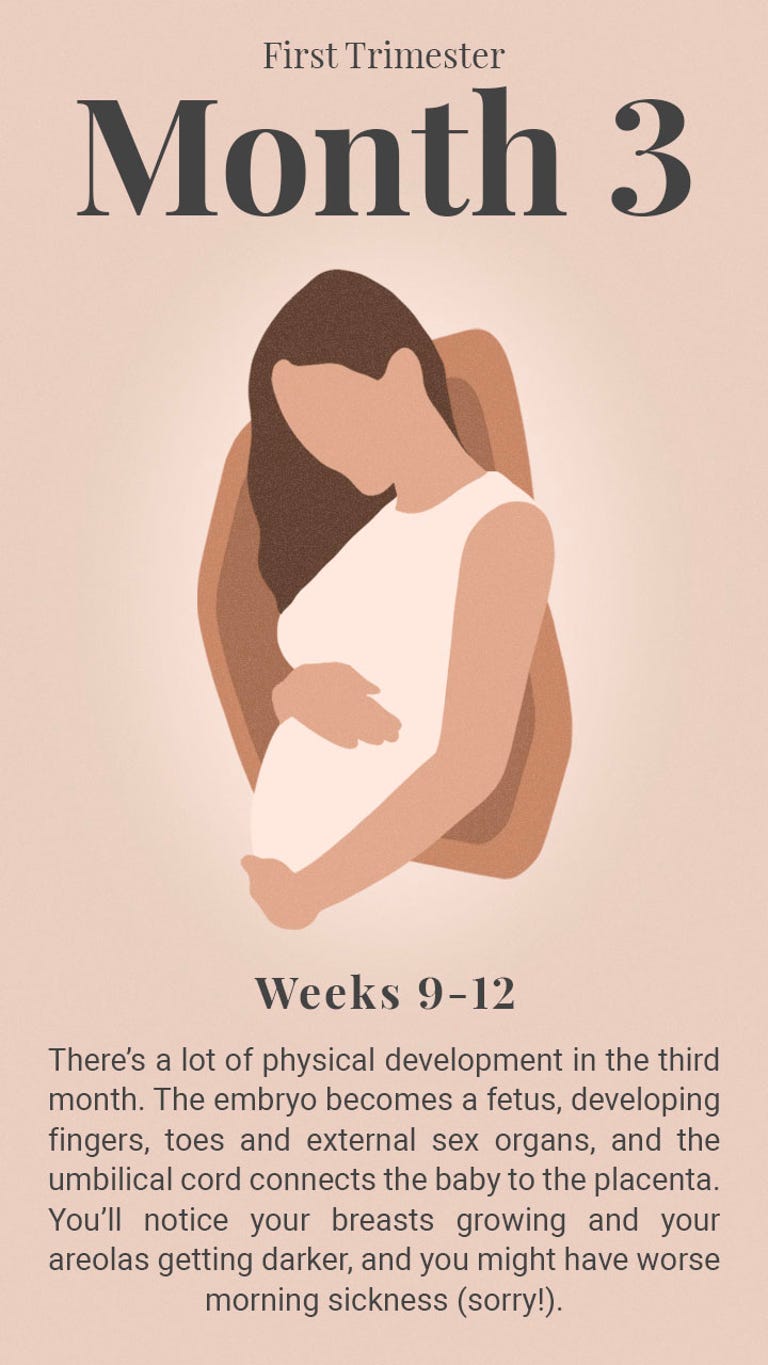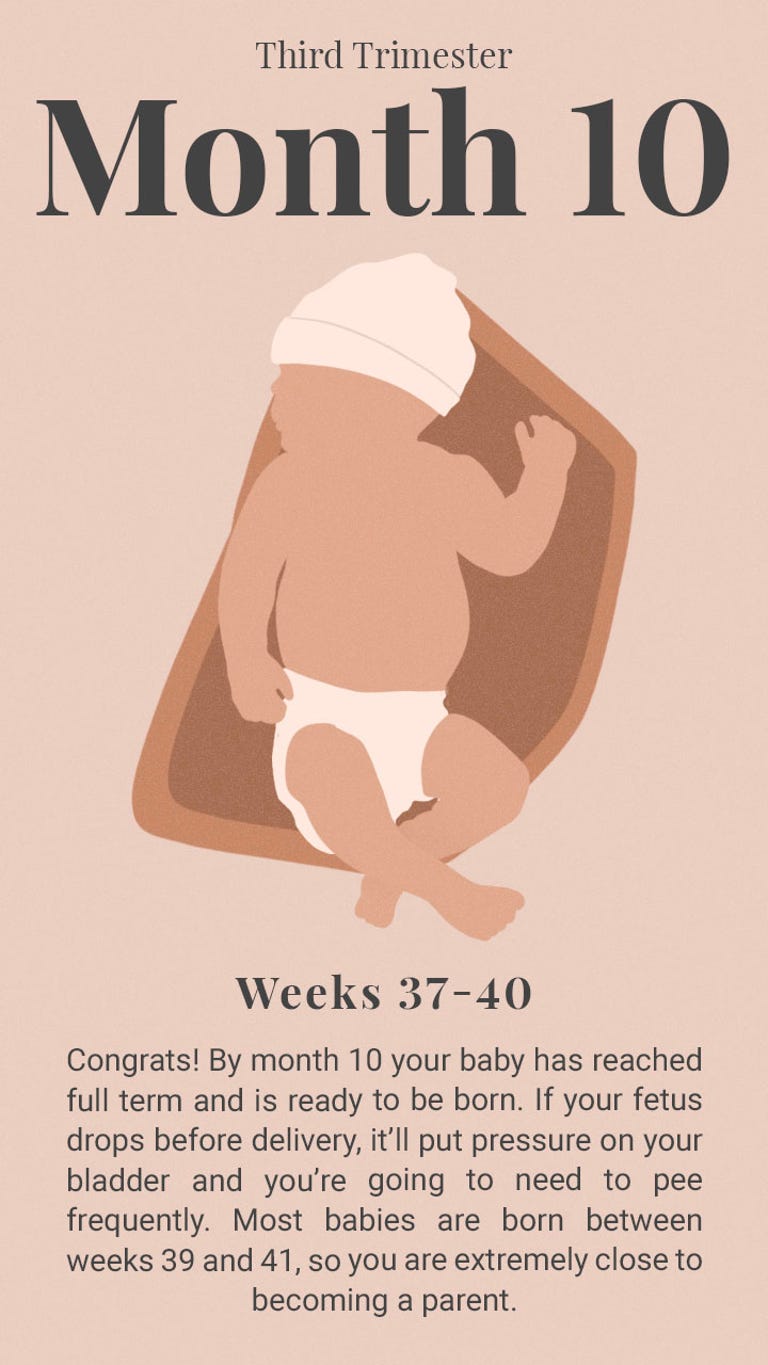Pregnancy, for most women (if not all), is a mix of feeling both excited and nervous at the same time. You can’t wait to hold your baby in your arms after 9 months but also feel anxious about all the changes your body is going through externally and internally. The pregnancy symptoms continue to change and evolve, so it can be scary trying to figure out what’s normal and what’s not. Below we outline the stages of pregnancy month by month to explain what to expect in your own body and how your baby develops along the way.
Keep in mind that every person’s body is different and you might not experience all of the symptoms and changes outlined below. You should always consult with your doctor if you have questions or concerns about your pregnancy.
Check out our visual pregnancy timeline and read on for a detailed guide to pregnancy by month and trimester.
First trimester
Did you know that the first month of pregnancy starts with the first day of your last period? By the time most people take an at-home pregnancy test (after you miss a period or right before it’s supposed to start), you’re typically considered around 4-5 weeks pregnant in the medical community.

Month 1 (weeks 1 through 4)
During your first month of pregnancy, you might not notice any obvious symptoms. One telltale sign for some is light spotting, which can indicate that an embryo has attached to the wall of your uterus. Typical month 1 symptoms include feeling more tired than usual, having to pee way more often, tender or painful breasts and morning sickness.
The process of pregnancy starts when an egg is fertilized with a single sperm, which creates a zygote. The zygote starts dividing and becomes an embryo as it travels down the fallopian tubes and attaches to the uterine wall — a process that takes several days. If it successfully attaches, you’re pregnant. If not, you’ll have a period, shedding the uterine lining and the embryo.
Month 2 (weeks 5 through 8)
By month 2, you’ve likely already seen an obstetrician and gotten an ultrasound to see the developing embryo. If you didn’t experience symptoms in the first month, you will now. Expect morning sickness, tender breasts, heartburn and a faster heart rate because your body produces more blood to support the baby.
Your baby goes through a lot of changes this month. The heart develops and starts beating. The beginnings of the spinal cord, brain and nervous system start to form, the umbilical cord develops and the buds of arms and legs sprout. Fingers, toes, eyes and ears start to form as well, closer to the end of month two.

Month 3 (weeks 9 through 12)
Congrats, you’ve made it to month 3! This is the time many parents-to-be start telling friends and family because the risk of a miscarriage goes down significantly.
The downside is that the symptoms from month two might get worse (sorry). You’ll notice your breasts growing and areolas getting darker. If you have acne, you might get more breakouts this month.
By month three, the embryo becomes a fetus. This is the time where the internal sex organs develop into the final forms — either ovaries and a uterus or testes and a penis. Early bones that started forming last month begin to harden and all of the organs have formed.
Second trimester
The second trimester is lauded as the best part of pregnancy, because the symptoms from the first trimester start to subside — goodbye, morning sickness! (Probably.) Your baby is now fully formed, but will keep growing and develop new features, such as hair and fingerprints.
Month 4 (weeks 13 through 16)
You’re almost halfway through pregnancy now, and you might be able to determine the baby’s sex on an ultrasound. Your heart is still pumping fast to move extra blood for you and the baby, so it’s normal if you feel dizzy or out of breath. That extra blood may cause nosebleeds or bleeding gums. You might also experience constipation, some back pain and start to notice a small baby bump forming.
Month 5 (weeks 17 through 20)
While you might not get full-on kicks yet, during month 5, you’ll start to feel flutters of movement as your fetus moves in the womb. Muscles are developing and hair starts to grow on the baby’s head.
Expect the same symptoms as month 4: heartburn, constipation and shortness of breath. You’ll also likely need new bras as your breasts go up a cup size or two.

Month 6 (weeks 21 through 24)
Your baby will be moving quite a bit by now: You’ll start to feel when they hiccup, kick and rotate in the womb. You might notice more constipation, bleeding gums and leg cramps than before. You might also start producing colostrum, the first stage of developing breast milk.
Braxton-Hicks contractions can pop up in month six. These contractions are usually painless and are normal — it’s just your body getting ready for labor. But if they are painful or happen often, call your doctor.
The medical community generally considers a fetus to be viable (meaning it can survive outside of the womb with medical interventions) at 24 weeks. Even with those interventions, there’s a significant risk that the baby will not survive.
A fetus born before 24 weeks might be able to survive, but only with specialized medical care. Even then, there’s only about a 6% chance that the baby will live.
Month 7 (weeks 25 through 28)
The seventh month of pregnancy likely won’t feel any different than month 6. You’ll have the same symptoms as before and should have a noticeable baby bump by now.
Your baby starts gaining body fat and its ears are fully developed, so it will respond to sounds and music. This is also the stage where you could have a baby prematurely and they are likely to survive with medical care. Babies are still considered “extremely preterm” before 28 weeks and are at increased risk of long-term health issues.
Third trimester
This is the home stretch; just a few months to go until you get to meet your baby. During this time, your body starts to get ready for labor and delivery.
Month 8 (weeks 29 through 32)
By now, you’re feeling the effects of carrying around a nearly full-term baby, including back pain and loose joints. Your belly will likely be sporting stretch marks as your fast-growing fetus makes your abdomen expand quickly. Your uterus is going to start pressing against your bladder, meaning you’ll have to pee a lot more often.
The upside? Those pregnancy hormones make your hair look more full and healthy.

Month 9 (weeks 33 through 36)
You’re almost there! In month nine, you’ll feel the same symptoms as month 8, including varicose veins, stretch marks and fatigue. Because your belly is at its largest point, you might have trouble getting comfortable to sleep (some pregnancy exercises can help with this).
Your baby is fully developed by now with working lungs and coordinated reflexes. They can survive outside the womb just fine.
Month 10 (Weeks 37 through 40)
Popular culture says that pregnancy lasts nine months, but most people actually deliver between nine and 10 months. Forty weeks is considered full term, but babies can be born later than that.
Congrats! By month 10 your baby is ready to be born. If your fetus drops before delivery, it’ll put more pressure on your bladder and you’re going to need to pee frequently. Be on the lookout for signs of labor, such as contractions that happen on a consistent schedule. Most babies are born between weeks 39 and 41, so you are extremely close to becoming a parent.
